[Updated August 3, 2018 by Shauvik Haldar]
For investors seeking well established blue chip stocks, the 30 stocks in the Dow Jones Industrial Average can be a great choice. All 30 of these stocks pay a regular dividend, but not all of the components offer an attractive yield.
Below is a dividend-focused analysis of the entire Dow 30, first focusing on summarizing the Dow 30 in five charts, and followed by an analysis of Dow companies that have increased their dividends over the past 50 years.
Summarizing the Dow 30 in 5 Charts
Dividend Yield
For dividend investors, an attractive yield is a must. Telecommunication giant Verizon Communications Inc. (VZ ) and technology leader IBM Corp (IBM ) are currently leading the Dow when it comes to dividend yield – both yielding over 4%. The chart below breaks down the Dow 30 components according to yield.
Click here for more information on dividend yield.
Consecutive Dividend Increases
To determine dividend reliability, many investors check to see the number of years a company has consecutively raised its dividend. Four companies in the current Dow have raised dividends for over 50 years, showing exceptional commitment to its dividend investors.
The Industries of the Dow
The aim of the Dow is to represent market diversity. Below is an overview of which industries are in the Dow 30.
The Best and Worst Dow Dividend Payers
The average yield of the Dow in 2018 was 2.5%, but there are several stocks that are well above or below the average. Verizon’s yield exceeds all other Dow members, while Visa (V ) was the lowest-yielding Dow stock for the year.
Total Cash Dividends Paid by Dow 30 Companies
In 2018, the combined cash dividends paid out by the Dow 30 blue chips totaled a staggering $156.1 billion.
Here’s another way to put this mind-boggling figure into perspective:
That’s right, the combined cash dividends paid out by the 30 blue chips exceeds the gross domestic product of well over 140 countries.
Biggest Dividend Payers
The total dividends paid, profiled above, is by all means impressive, but what’s even more noteworthy is the fact that just four of the 30 stocks contributed to roughly one-third of the $156.1 billion distribution. In other words, the four biggest payers combined returned approximately $47.1 billion in dividends to shareholders last year.
From the group, Exxon (XOM ) was the biggest payer, with a distribution of over $13 billion, with Apple (AAPL ) a close second at nearly $12.8 billion. On the other end of the spectrum lies Travelers Co. (TRV ), which had the smallest cash distribution, totaling $790 million.
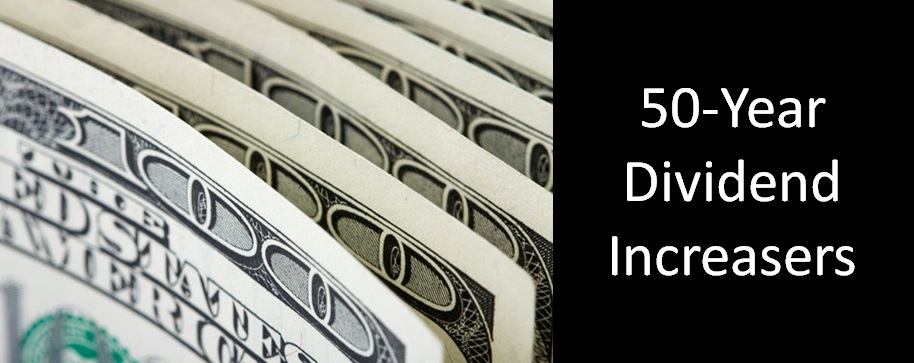
The Coca-Cola Company
Beverage company The Coca-Cola Company (KO ) joined the Dow 30 in 1987. The company initiated its first dividend in 1920 and has consecutively raised its dividend every year since 1963. Coca-Cola is a well-know dividend payer, but its biggest rival PepsiCo, Inc. (PEP ) has a comparable record – raising dividends every year since 1973. Additionally, as of March 2018, KO is the third-largest holding of Warren Buffett’s Berkshire Hathaway Inc, behind Wells Fargo & Co (WFC ) and Bank of America Corp (BAC ).
For more information check out Coke Stocks: Which Is Best for Dividend Investors?
Annual Dividend Increases
| 2013 | 2014 | 2015 | 2016 | 2017 |
|---|---|---|---|---|
| 9.8% | 8.9% | 8.2% | 6.1% | 5.7% |
Johnson & Johnson
New Jersey-based drug company Johnson & Johnson (JNJ ) became a member of the Dow in 1997 and has been boosting its dividend every year since 1963. Over the past five years, JNJ has offered a dividend yield between 2.4% and 3.1%, which is above its peers. JNJ typically announces dividend increases in April, and tends to raise its quarterly dividend by 6%-8%.
See Also: How Much Dividend-Paying Drug Makers Spend on Research and Development.
Annual Dividend Increases
| 2013 | 2014 | 2015 | 2016 | 2017 |
|---|---|---|---|---|
| 7.9% | 6.6% | 6.9% | 6.8% | 5.4% |
3M
Technology company 3M Co (MMM ) entered the Dow in 2002. The St. Paul, MN-based company initiated its first dividend of 6 cents per share in 1916 and has been raising its dividend consecutively every year since 1959. Over the past five years, MMM has yielded between 2% and 2.9%, increasing its dividend each February.
Annual Dividend Increases
| 2013 | 2014 | 2015 | 2016 | 2017 |
|---|---|---|---|---|
| 7.6% | 34.6% | 19.9% | 8.3% | 5.9% |
The Procter & Gamble Company
Consumer goods company The Procter & Gamble Company (PG ) is a long time member of the Dow – entering in 1932. PG has raised its dividend for its shareholders every year since 1957. Over the past five years, PG has offered a dividend yield in the range of 2.8%-3.8%.
Annual Dividend Increases
| 2013 | 2014 | 2015 | 2016 | 2017 |
|---|---|---|---|---|
| 7.0% | 7.0% | 3.9% | 15% | 2.5% |
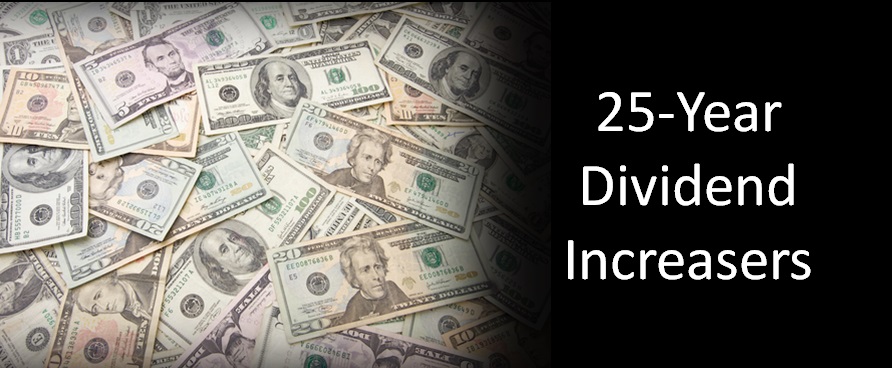
Wal-Mart
Discount retailer Wal-Mart Stores, Inc. (WMT ) became a Dow component in 1997. The company has been lifting its dividend every year since it first initiated its dividend in 1974. Over the last few years, the company has offered dividend investors a decent yield of 2.3%, above the average among its peers. WMT tends to raise its dividend in late February or early March every year.
Be sure to also view: Wal-Mart and the Recession Factor.
Annual Dividend Increases
| 2013 | 2014 | 2015 | 2016 | 2017 |
|---|---|---|---|---|
| -27.9% | 35.5% | 2.1% | 2.1% | 2.0% |
McDonald’s
Fast food giant McDonald’s Corporation (MCD ) became a Dow component in 1985. The company first started paying an annual dividend in 1977 and has been raising its dividend every year since. In 2008, MCD began paying its dividend quarterly. Over the past five years, MCD has offered a dividend yield of 2.5%-3.5% – well above its peers. Over the last few years, the company has been raising its dividend, typically by at least 5%, each September.
See Also: Restaurant Dividend Stocks: How They Stack Up.
Annual Dividend Increases
| 2013 | 2014 | 2015 | 2016 | 2017 |
|---|---|---|---|---|
| 8.7% | 5.1% | -21.0% | 39.4% | 6.1% |
Exxon
Irving, TX-based Exxon Mobil Corporation (XOM ), which was previously named Standard Oil of New Jersey, first entered the Dow in 1928. XOM has been raising its quarterly dividend every year since 1983. Over the past five years, XOM has averaged a 3% dividend yield, which is higher than the industry average. XOM raises its quarterly dividend each April.
Be sure to also check out The Complete Visual History of Standard Oil.
Annual Dividend Increases
| 2013 | 2014 | 2015 | 2016 | 2017 |
|---|---|---|---|---|
| 12.8% | 9.8% | 6.7% | 3.5% | 2.7% |
Chevron
Chevron Corporation (CVX ) entered the Dow in 2008 and has boosted its quarterly dividend every year since 1986. CVX’s 3.9% yield over the past five years is higher than its peers. The company has raised its dividend intermittently during the past five years amid the oil price collapse. It announces its dividend changes every April.
Annual Dividend Increasers
| 2013 | 2014 | 2015 | 2016 | 2017 |
|---|---|---|---|---|
| 11.1% | 7.9% | 1.7% | 0.2% | 0.7% |
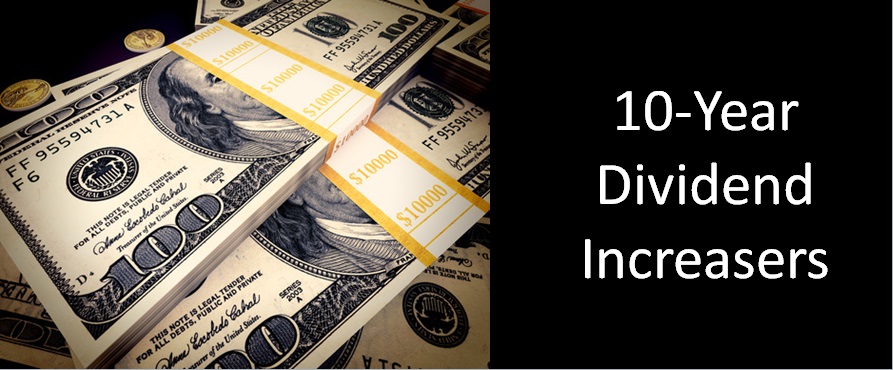
Microsoft
Software giant Microsoft Corporation (MSFT ) entered the Dow in 1999 and has been lifting its dividend since 2010. Over the past five years, MSFT has averaged a 2.5% yield – higher than its peers. The company is not a long-term dividend increaser, but it has impressed investors in the last few years with significant dividend increases. MSFT declares its dividend increases in September every year.
Annual Dividend Increases
| 2013 | 2014 | 2015 | 2016 | 2017 |
|---|---|---|---|---|
| 16.9% | 18.6% | 12.2% | 14.0% | 8.2% |
IBM
International Business Machines Corp. (IBM ) became a member of the Dow in 1979 and has been lifting its quarterly dividend every year since 2000. The company typically raises its dividend by over 7% each year, announcing its dividend increases each year in April. Over the past five years, IBM’s yield has jumped from around 2% to above 4%.
See Also: How Does IBM Make Money?.
Annual Dividend Increases
| 2013 | 2014 | 2015 | 2016 | 2017 |
|---|---|---|---|---|
| 12.1% | 14.9% | 17.6% | 10.0% | 7.3% |
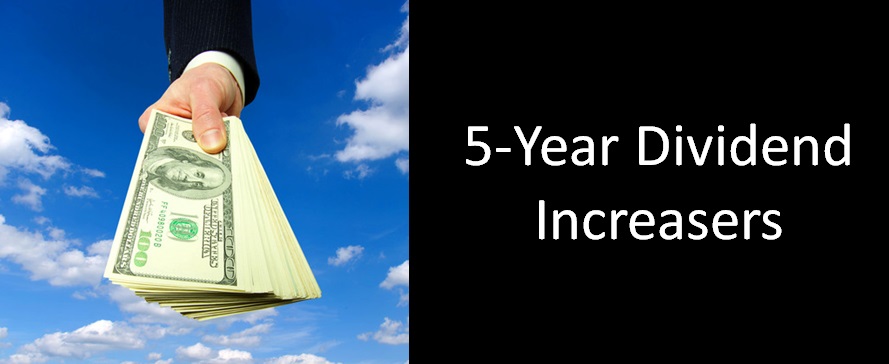
Verizon
New York City-based Verizon Communications Inc. (VZ ) became a Dow component in 2004 and has been raising its quarterly dividend by a small amount every year since 2007. VZ is a top yielder of the Dow, yielding an average of 5% over the past five years. Since 2007, VZ has announced dividend increases every September.
See Also: 7 Charts That Compare AT&T and Verizon.
Annual Dividend Increases
| 2013 | 2014 | 2015 | 2016 | 2017 |
|---|---|---|---|---|
| 3.0% | 3.1% | 3.5% | 2.6% | 2.2% |
Travelers Companies
In 2009, Travelers Companies Inc (TRV ) became a member of the Dow. That year, TRV also raised its dividend by 3.4% and has been raising it every year since. TRV has held an average yield of 2.4% over the past five years, falling below its peers. Each April, the company declares an increased quarterly dividend.
Annual Dividend Increases
| 2013 | 2014 | 2015 | 2016 | 2017 |
|---|---|---|---|---|
| 9.5% | 9.7% | 10.7% | 10.1% | 8.0% |
Nike
Nike Inc (NKE ) joined the Dow in 2013, replacing Alcoa (AA ). The footwear maker has lifted its dividend most years since the 2008 financial crisis. Dividend growth surged double digits between 2012 and 2016, before falling sharply in 2017. As such, Nike is still one of the lowest-yielding Dow stocks. NKE announces its dividend increases in November of each year.
Be sure to also check out 7 Things Most Investors Don’t Know About Nike Inc.
Annual Dividend Increases
| 2013 | 2014 | 2015 | 2016 | 2017 |
|---|---|---|---|---|
| -23.6% | 52.4% | 16.7% | 42.9% | -10.0% |
Visa
Visa Inc (V ) replaced Hewlett-Packard Company (HPQ ) for its spot in the Dow 30 in 2013. Although the company has been increasing its dividend every year since 2009, the stock has not done much to impress dividend investors. Yielding under 1%, V yields well below its peers. Visa raises its dividend every October, and typically announces significant dividend increases.
Annual Dividend Increases
| 2013 | 2014 | 2015 | 2016 | 2017 |
|---|---|---|---|---|
| 40.4% | 20.9% | 19.0% | 17.0% | 17.9% |
Pfizer
Pfizer Inc. (PFE ) became a Dow component in 2004. The biopharmaceutical company has been raising its dividend every year since 2010. Although PFE has not been a long term dividend raiser,it has boosted its dividend by around 21% during the last three years and offered a 3.5% average yield since 2011 – making it one of the highest dividend payers of the Dow. With its average yield, PFE tops the average yield of its peers. PFE has been raising its dividend yield for investors each December.
Annual Dividend Increases
| 2013 | 2014 | 2015 | 2016 | 2017 |
|---|---|---|---|---|
| 9.1% | 8.3% | 7.7% | 7.1% | 6.7% |
Home Depot
The Home Depot, Inc. (HD ) has been a member of the Dow since 1999. The company has no long-term dividend increasing history, but it did double its yield between 2014 and 2018. HD has yielded an average of 2.1% over the past five years, which is in line with its peers.
Annual Dividend Increases
| 2013 | 2014 | 2015 | 2016 | 2017 |
|---|---|---|---|---|
| 34.5% | 20.5% | -5.9% | 55.9% | 20.9% |
Disney
Entertainment company The Walt Disney Company (DIS ) joined the Dow in 1991 and has been raising its dividend every year since 2010. DIS switched to an annual payout in 1990 and has been offering investors an average yield of just 1.4% over the last five years. The company pays its annual dividend in November or December every year.
See Also: 7 Things Most Investors Don’t Know About The Walt Disney Company.
Annual Dividend Increases
| 2013 | 2014 | 2015 | 2016 | 2017 |
|---|---|---|---|---|
| 237.5% | -36.3% | 110.5% | -21.5% | 9.9% |
UnitedHealth Group
UnitedHealth Group Inc. (UNH ) became a Dow component in 2012. The healthcare company has offered an average dividend yield of just 1.6% over the past five years, yielding in line with its peers. Investors can expect UNH to announce future dividend increases in May or June.
Annual Dividend Increases
| 2013 | 2014 | 2015 | 2016 | 2017 |
|---|---|---|---|---|
| 31.6% | 33.5% | 33.5% | 26.7% | 21.1% |
Caterpillar
Caterpillar Inc. (CAT ) entered the Dow in 1991 and has been lifting its dividend since 2010. The company held an average dividend yield of 3.1% over the last five years, which is well above its peers. CAT announces its dividend increases in June.
Annual Dividend Increases
| 2013 | 2014 | 2015 | 2016 | 2017 |
|---|---|---|---|---|
| -30.6% | 51.2% | 13.1% | 4.8% | 0.6% |
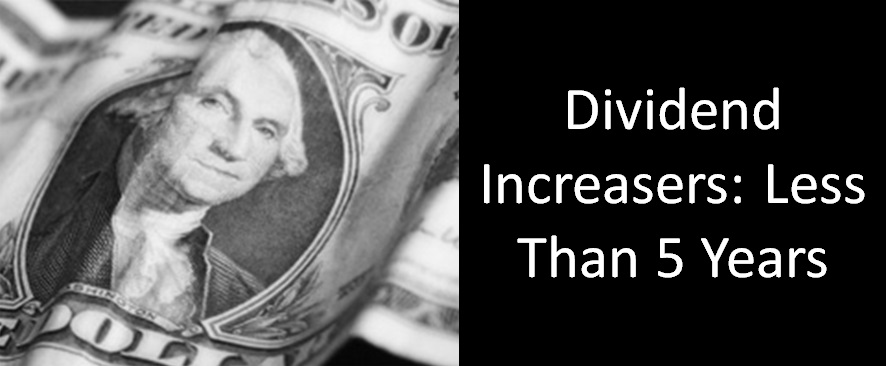
Merck
Merck & Co., Inc. (MRK ) premiered in the Dow in 1979. The New Jersey-based healthcare company has been modestly raising its dividend since 2012. Despite its lack of dividend increasing history, MRK has averaged a yield of 3.2% over the past five years, which is well above the industry average. Dividend investors can expect MRK’s dividend increases to occur in November.
Annual Dividend Increases
| 2013 | 2014 | 2015 | 2016 | 2017 |
|---|---|---|---|---|
| 2.4% | 2.3% | 2.3% | 2.2% | 2.2% |
Boeing
Long time dividend payer The Boeing Company (BA) joined the Dow in 1987. The aerospace company has been raising its dividend since 2012. Although the company does not have much history when it comes to consecutive dividend increasing, BA has announced large dividend increases in recent years, including 20% in 2017 and 30% in 2016. Over the past five years, BA has offered an average dividend yield of 2.5%, which is in line with its peers. BA has been announcing dividend increases each December.
Annual Dividend Increases
| 2013 | 2014 | 2015 | 2016 | 2017 |
|---|---|---|---|---|
| 10.2% | 50.5% | 24.7% | 19.8% | 30.3% |
United Technologies
United Technologies Corporation (UTX ) became a member of the Dow in 1991. The company has been raising its quarterly dividend only since 2012, but has offered investors significant increases. UTX’s 2.3% average yield over the last five years comes in slightly above its peers.
Annual Dividend Increases
| 2013 | 2014 | 2015 | 2016 | 2017 |
|---|---|---|---|---|
| 8.1% | 7.5% | 8.5% | 2.3% | 3.8% |
American Express
American Express Company (AXP ) has been a Dow component since 1982 and has been lifting its dividend since 2012. After maintaining the same dividend payout amount since 2007, AXP finally increased its quarterly dividend by 11% in 2012 and then again by 15% in 2013. AXP’s five-year average dividend yield of 1.5% falls well below the average yield of other companies in the credit services industry.
Annual Dividend Increases
| 2013 | 2014 | 2015 | 2016 | 2017 |
|---|---|---|---|---|
| 10.3% | 14.0% | 12.2% | -18.2% | 45.6% |
Goldman Sachs
Goldman Sachs Group Inc (GS ) replaced Bank of America (BAC ) in the Dow in 2013. The investment bank has been raising its dividend since 2012, and is one of the lowest-yielding Dow stocks. The stock’s yield falls well below its competitors.
Annual Dividend Increases
| 2013 | 2014 | 2015 | 2016 | 2017 |
|---|---|---|---|---|
| 15.8% | 9.8% | 13.3% | 2.0% | 11.5% |
DowDuPont
DowDuPont (DWDP), formerly E. I. du Pont de Nemours and Company, became a member of the Dow back in 1935. DowDuPont company resulted from the successful merger of Dow Chemical Company and du Pont de Nemours in 2017. Since the merger was completed in September 2017, DWDP has yielded an average of 2.2%, which is in line with the industry standard.
Annual Dividend Increases
| 2013 | 2014 | 2015 | 2016 | 2017 |
|---|---|---|---|---|
| N/A |
Intel
Intel Corporation (INTC) joined the Dow in 1999. Over the last five years, INTC has averaged a 3.1% dividend yield, which is higher than other semiconductor companies. Although INTC has an attractive dividend yield, the company has not been consistent with dividend increases. In 2013, INTC did not raise its quarterly dividend – breaking the streak of consecutive dividend increasing years.
Annual Dividend Increases
| 2013 | 2014 | 2015 | 2016 | 2017 |
|---|---|---|---|---|
| 3.4% | 0.0% | 6.7% | 8.3% | 3.6% |
Cisco
Technology company Cisco Systems, Inc. (CSCO ) became a Dow component in 2010 and has been consecutively raising its quarterly dividend since 2011. Over the past five years, CSCO has held an average dividend yield of 3.2% – higher than other companies in the technology industry. CSCO has been declaring increased quarterly dividend payouts in February recently.
Annual Dividend Increases
| 2013 | 2014 | 2015 | 2016 | 2017 |
|---|---|---|---|---|
| 2.0% | 45.1% | 10.8% | 20.7% | 14.1% |
Apple
Technology giant Apple, Inc. (AAPL ) joined the Dow in 2015 and has since grown to become the most valuable publicly traded company of all time. AAPL began paying dividends consistently in 2013, and has since grown its yield to an average of 1.5% – in line with the broader technology industry. In recent years, the company has announced its dividend payouts in May.
Annual Dividend Increases
| 2013 | 2014 | 2015 | 2016 | 2017 |
|---|---|---|---|---|
| 256.2% | 9.5% | 10.0% | 9.9% | 10.3% |
Wallgreens Boots Alliance
Wallgreens Boots Alliance, Inc. (WBA ) is the latest addition to the Dow, joining the blue-chip index in 2018. In doing so, the pharmaceutical giant instantly became one of the Dow’s most prolific dividend payers, having grown its payouts each year since 1976. The company yields 2.5% and has grown its annual dividend by at least 4% over the past five years. WBA usually declares its dividend in April or June.
Annual Dividend Increases
| 2013 | 2014 | 2015 | 2016 | 2017 |
|---|---|---|---|---|
| 18.0% | 10.6% | 6.9% | 5.4% | 5.4% |
JPMorgan Chase
Wall Street banking giant JPMorgan Chase & Co (JPM ) has had a seat on the Dow 30 index at various points throughout its history. Although the company doesn’t have an established track record paying dividends, it has been a positive dividend grower for the past seven years. However, its average five-year yield of 2.6% is below the financial industry average. JPMorgan announces its dividend payouts at various times throughout the year.
Annual Dividend Increases
| 2013 | 2014 | 2015 | 2016 | 2017 |
|---|---|---|---|---|
| 18.3% | 14.7% | 7.7% | 9.5% | 10.9% |
Fun Facts
As impressive as the total cash dividends figure paid by the Dow 30 is on its own, putting a number that big into perspective can be quite baffling. So, just how much is $156.1 billion? Well, let’s just say that:
- The combined dividends of the Dow 30 companies can pay off almost a quarter of the United States’ 2017 federal budget deficit of $666 billion.
- With the $156.1 billion paid out by the Dow 30, you could purchase either of Phillip Morris International (PM ), IBM (IBM ), United Parcel Service (UPS ) or Qualcomm (QCOM ).
- The annual $156.14 billion dividend of the Dow 30 companies equates to $4,951.16 per second per year, assuming a hypothetical distribution of 365 days a year.





